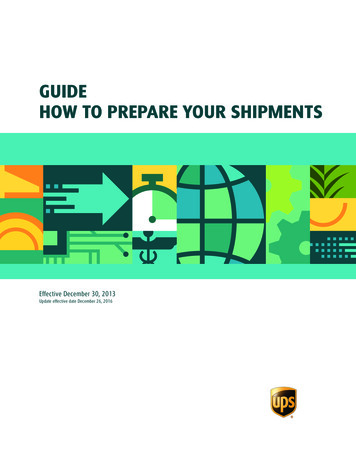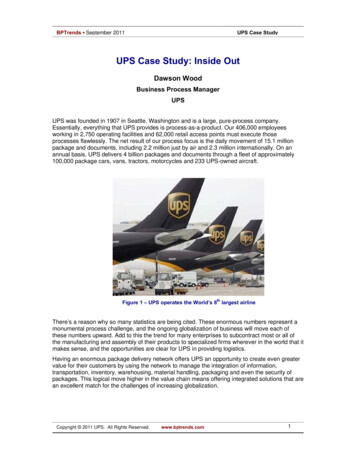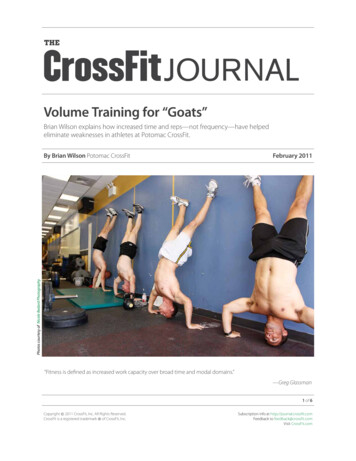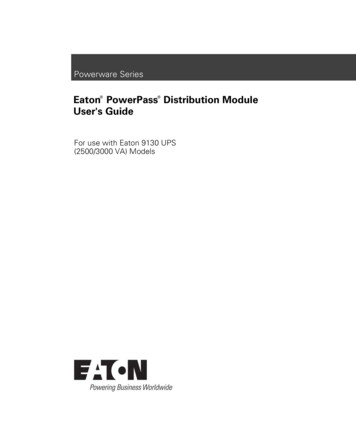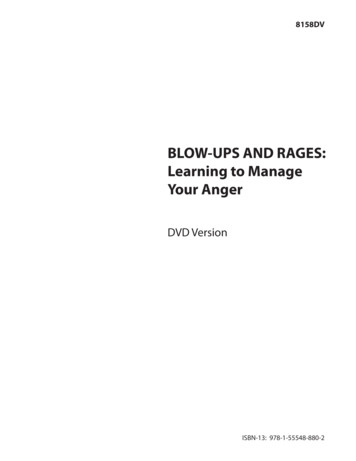
Transcription
8158DVBLOW-UPS AND RAGES:Learning to ManageYour AngerDVD VersionISBN-13: 978-1-55548-880-2
Blow-Ups and Rages: Learning to Manage Your AngerCreditsExecutive ProducerAnson W. SchloatProducerJohn G. YoungConsultantRobin F. Goodman, Ph.D., A.T.R.-B.C.Teacher’s Resource BookTed AlvarezCopyright 2011Human Relations Media, Inc.H uman R elations M ediaB low -U psandR ages
Blow-Ups and Rages: Learning to Manage Your AngerTable of ContentsDVD Menu. . . . . . . . . . . . . . . . . . . . . . . . . . . . . . . . . . . . . . . . . . . . . . . . . . . . . . . . . . . . . . . . . . . . . . . iIntroduction. . . . . . . . . . . . . . . . . . . . . . . . . . . . . . . . . . . . . . . . . . . . . . . . . . . . . . . . . . . . . . . . . . . . 1Learning Objectives. . . . . . . . . . . . . . . . . . . . . . . . . . . . . . . . . . . . . . . . . . . . . . . . . . . . . . . . . . . . . 2Program Summary. . . . . . . . . . . . . . . . . . . . . . . . . . . . . . . . . . . . . . . . . . . . . . . . . . . . . . . . . . . . . . 3Pre/Post Test Answer Key. . . . . . . . . . . . . . . . . . . . . . . . . . . . . . . . . . . . . . . . . . . . . . . . . . . . . . . . 5Student Activities1.2.3.4.5.6.7.8.9.10.11.12.Pre/Post Test. . . . . . . . . . . . . . . . . . . . . . . . . . . . . . . . . . . . . . . . . . . . . . . . . . . . . . . . . . . 7Anger and Your Body. . . . . . . . . . . . . . . . . . . . . . . . . . . . . . . . . . . . . . . . . . . . . . . . . . . 9Looking Back. . . . . . . . . . . . . . . . . . . . . . . . . . . . . . . . . . . . . . . . . . . . . . . . . . . . . . . . . . 10Research Project . . . . . . . . . . . . . . . . . . . . . . . . . . . . . . . . . . . . . . . . . . . . . . . . . . . . . . 11Celebrity Meltdowns. . . . . . . . . . . . . . . . . . . . . . . . . . . . . . . . . . . . . . . . . . . . . . . . . . 13In the News. . . . . . . . . . . . . . . . . . . . . . . . . . . . . . . . . . . . . . . . . . . . . . . . . . . . . . . . . . . 14Working It Out. . . . . . . . . . . . . . . . . . . . . . . . . . . . . . . . . . . . . . . . . . . . . . . . . . . . . . . . 15Using “I” Statements. . . . . . . . . . . . . . . . . . . . . . . . . . . . . . . . . . . . . . . . . . . . . . . . . . . 17Freeze Out Unhealthy Anger. . . . . . . . . . . . . . . . . . . . . . . . . . . . . . . . . . . . . . . . . . . 20Anger: A Tool from the Past? . . . . . . . . . . . . . . . . . . . . . . . . . . . . . . . . . . . . . . . . . . 21Finding Your Safe Zone. . . . . . . . . . . . . . . . . . . . . . . . . . . . . . . . . . . . . . . . . . . . . . . . 22Top 100 Ways to Blow Off Steam. . . . . . . . . . . . . . . . . . . . . . . . . . . . . . . . . . . . . . . 23Fact Sheets1.2.3.4.5.6.7.8.9.10.11.12.13.What Is Anger?. . . . . . . . . . . . . . . . . . . . . . . . . . . . . . . . . . . . . . . . . . . . . . . . . . . . . . . . 24The Physical Effects of Anger . . . . . . . . . . . . . . . . . . . . . . . . . . . . . . . . . . . . . . . . . . 25The Sequence of Anger. . . . . . . . . . . . . . . . . . . . . . . . . . . . . . . . . . . . . . . . . . . . . . . . 26Temper-Taming Tools. . . . . . . . . . . . . . . . . . . . . . . . . . . . . . . . . . . . . . . . . . . . . . . . . . 27Learning to Cool Down. . . . . . . . . . . . . . . . . . . . . . . . . . . . . . . . . . . . . . . . . . . . . . . . 28Conflict Resolution Steps. . . . . . . . . . . . . . . . . . . . . . . . . . . . . . . . . . . . . . . . . . . . . . 30Assertive Communication. . . . . . . . . . . . . . . . . . . . . . . . . . . . . . . . . . . . . . . . . . . . . 32The Power of “I” Statements. . . . . . . . . . . . . . . . . . . . . . . . . . . . . . . . . . . . . . . . . . . . 33How to Listen. . . . . . . . . . . . . . . . . . . . . . . . . . . . . . . . . . . . . . . . . . . . . . . . . . . . . . . . . 34Safe Spot Scenarios . . . . . . . . . . . . . . . . . . . . . . . . . . . . . . . . . . . . . . . . . . . . . . . . . . . 35Do You Need Help?. . . . . . . . . . . . . . . . . . . . . . . . . . . . . . . . . . . . . . . . . . . . . . . . . . . . 36Sources. . . . . . . . . . . . . . . . . . . . . . . . . . . . . . . . . . . . . . . . . . . . . . . . . . . . . . . . . . . . . . . 37Bibliography. . . . . . . . . . . . . . . . . . . . . . . . . . . . . . . . . . . . . . . . . . . . . . . . . . . . . . . . . . 38Other Programs from Human Relations Media . . . . . . . . . . . . . . . . . . . . . . . . . . . . . . . . . . 39H uman R elations M ediaB low -U psandR ages
Blow-Ups and Rages: Learning to Manage Your AngerDVD MenuMAIN MENUPlayd Play with Spanish SubtitlesdThis option allows you to view the program with Spanish subtitles.Subtitles are enabled/disabled by selecting a button on the DVD playerremote or by using the remote to select subtitles from the menu button.dChapter SelectionFrom here you can access many different paths of the DVD, beginningwith the introduction and ending with the credits.1. Introduction2. A Problem with Anger3. Negative Consequences4. Finding the Source5. Don’t Suppress, Express Your Anger6. Finding Solutions7. Getting Help8. CreditsdTeacher’s Resource BookA printable file of the accompanying Teacher’s Resource Book isavailable on the DVD. Load the DVD onto a computer that hasa DVD-disk drive and Adobe Acrobat Reader.For PC users: From the “Start” menu, click on “My Computer,”then right click on your DVD disk drive and select “Explore.”Double click on the PDF document to open the Teacher’sResource Book.For Mac users: In “Finder,” click on the DVD under “Devices.”Then click on the PDF document to open the Teacher’sResource Book.H uman R elations M ediaiB low -U psandR ages
Blow-Ups and Rages: Learning to Manage Your AngerIntroductionEveryone gets angry. Anger is an emotion like any other. It’s normal to get angry, and it’simpossible to resist feeling angry sometimes. The problem with anger is not the simple fact thatit happens—it’s that some people feel it too intensely and too often and don’t use the right skillsto manage their anger effectively.Partner abuse, road rage, workplace violence and divorce are a few examples of the resultsof poor anger management skills. Moreover, anger can lead to physical problems when notproperly handled. Long-term anger has been linked to chronic headaches, sleep disorders,digestive problems, high blood pressure and heart attacks.For some adolescents, anger is especially difficult to control. When this powerful emotion getsmixed with surging hormones and the stressful situations that teens often face, it can quicklybecome a problem. Explosions of teen anger can be troubling, harmful and hurtful. Hostileexpressions of anger can devastate a teen’s life, destroy relationships, cloud effective thinking,affect physical health and ruin future plans. Yet it is possible for teens to learn how to prevent,express and cope with their angry feelings. The key is to better understand one’s personaltriggers, recognize thoughts and feelings associated with the anger and learn how to react inways that are productive rather than destructive.In prehistory, anger was often an effective defense mechanism because it prepared the body for“fight or flight.” In today’s world, expressing anger is more complex, yet our bodies continue toreact in ways similar to our primitive ancestors. Sometimes our perception of an insult or threat isenough to ignite our anger, even if there is no real threat or confrontation.On the other hand, anger can be useful when it promotes positive change. Anger is often theresult or consequence of other difficult emotions. When these feelings are addressed, it’s possibleto learn about ourselves, grow from our experiences and build stronger relationships—allpositive, empowering behaviors.The video Blow-Ups and Rages: Learning to Manage Your Anger uses dramatic, thoughtprovoking interviews with real teenagers to assure viewers that anger is a natural emotion. It isour response to anger that may need attention—not the simple fact of feeling the emotion itself.The video and activities in this Teacher’s Resource Book offer your students a range of commonsense tips and advice that will help them more confidently cope with their angry responses todaily stresses. These tips include the basic strategies of anger management: recognizing angertriggers, taking a breath before reacting, defusing situations by talking, learning relaxationtechniques and more.H uman R elations M edia1B low -U psandR ages
Blow-Ups and Rages: Learning to Manage Your AngerLearning ObjectivesAfter watching the video Blow-Ups and Rages: Learning to Manage Your Anger andparticipating in the activities in this Teacher’s Resource Book, your students will be able to:drecognize physical and emotional signs of anger in both themselves and othersdunderstand that anger is a normal emotionddefine the types of anger and recognize their various dangersdunderstand the triggers that cause anger in themselves and othersdlearn effective strategies for managing anger before it gets out of controlddiscover healthy ways to express anger and angry feelingsdestablish critical cool-down techniques to reduce stress andavoid angry outburstsdreplace hurtful communication with positive communication thatleads to resolutionduse “I” statements to reach a resolution during disagreements withfamily, friends and teachersdlearn how to listen more effectivelyddetermine their level of angerdlearn when and how to seek professional helpdfind ways to use anger positivelyB low -U psandR ages2H uman R elations M edia
Blow-Ups and Rages: Learning to Manage Your AngerProgram SummaryThe program begins with several teens describing moments of anger. One girl says, “When youlet your anger out in the wrong way, it’s going to come back and haunt you.” A young man adds,“It just came to the point where I would just lock myself in my room and not want to be aroundanybody.” Another says, “I would physically lash out I’d push other teammates and yell at them.”Robin F. Goodman, PhD, a clinical psychologist specializing in teen anger, appears on-screen. “It’sunfortunate that we grow up with people telling us that being angry is bad,” she says. “Actually,being angry is normal. Anger can get you into trouble when the feeling of anger turns intoaggression, which is actually acting out your anger. There are all sorts of other ways you can actout your anger that can be helpful if you do it in a positive way.”Next we meet four teens: Jeffrey, Alexa, Beryl and Jetaime. They describe their problems withanger: Jeffrey exploded over a missed shot during his senior championship basketball game;Alexa clashed with her father over attending a party; Beryl has always had trouble getting alongwith his mom and Jetaime got into a fight while defending her cousin from bullies. One speaker,a young man named Zyron, explains that his anger was usually directed at himself. He says: “Idon’t know, at times I would just cry tears of anger from not handling situations well, I wouldconstantly just replay back things, like why didn’t I do things this way, why didn’t I say something,why didn’t I speak up?”The young people explain the extreme reactions brought on by their anger. Jeffrey punchedhimself in the head and began yelling at his teammates, Jetaime responded to the bullies’ threatswith violence, Alexa slammed the door to her room and cried uncontrollably and Zyron regularlyskipped meals to punish himself.“Lots of times what happens with anger is [that] we try and stuff it down,” Dr. Goodman explains.“It’s almost like a Jack-in-the-box: it blows up. Then it’s much more hurtful. If you think about it:little anger, little solutions; big anger, big consequences.”Next, all the teens share the consequences of their anger. Zyron missed out on spending timewith his friends, Beryl scared his friends away by fighting with his parents in their presence, Jeffreyalienated his teammates and coach and Jetaime caused physical injuries during her fight. “I thinkI could have done a lot better,” she admits.Dr. Goodman says, “It’s great to be a detective about your anger. Look at all the clues. The angeris the result, and you want to figure out how you got there. Let’s say you’re feeling rejected,frustrated, disappointed, threatened or guilty. Sometimes it provokes feelings of anger, and so itmay be the result of other feelings you experience.”Jetaime, Beryl, Zyron and Alexa explain how fear, sadness and peer pressure might havepropelled their anger. Alexa felt pressure from her friends to go to a party. Zyron set unrealisticgoals for himself in school and with his part-time job, and then got depressed when he couldn’tmeet them.H uman R elations M edia3B low -U psandR ages
Blow-Ups and Rages: Learning to Manage Your AngerProgram Summary continuedJeffrey recalls that his friends helped him identify the sources of his anger. “We’d put things intoperspective. They’d help me realize, you’re feeling guilty, you’re feeling shameful, you’re feelinginsecure,” he says. “It’s hard to think that about yourself, but when you finally realize, I’m notperfect, this is who I am, these are the feelings I’m feeling, it helps you make progress.”Dr. Goodman tells viewers that anger is one of our most primitive emotions, which is why ourbody taps into anger when we feel stressed or overwhelmed. “Your body is thinking, I’m notgoing to survive this, I need to do something,” she says. “The anger is not really related to asurvival situation, but your body and mind are reacting as if it was. So you need to learn anappropriate response.”Each teen returns to explain how verbal expression—not suppression—of anger can help diffusestrong feelings and lead to positive solutions. “When you hold anger in, that’s a punishmentwithin itself, to do to yourself,” says Zyron. Alexa adds, “By not saying my feelings, and by not eventrying to have a dialogue with my father, I think that was really bad. It’s so much better to say,instead of, I hate you or I’m angry, to say, I feel hurt. I feel belittled. I feel embarrassed.”Dr. Goodman shares the importance of identifying specific activities that make you feel betterand cope with the stress immediately. They might include sports, music, calling a friend, cooking,painting and journaling. “It changes the track your emotions are on and it’s also a physical outlet.Anger can cause a physical reaction in your body. You want to do something to change thatreaction, calm it down, channel it somewhere else,” she advises. “When you take a step back andlook at what part you might have played in the situation, or what you contributed to a situationthat made you angry, it also means that you can also do something to make it better.”Beryl, Alexa, Jeffrey, Jetaime and Zyron all describe the personal activities they use to calmthemselves down. “I usually like to step away from the situation for a few minutes, like maybe atschool, if I’m upset I might go to the bathroom and just take a breather, wash my hands, wash myface,” Alexa says. Journaling helps Zyron control his anger. “It’s helped me a lot by just writingdown how I feel,” he says. “A journal is definitely a necessity. I keep a journal and whenever I’mfeeling emotional, it’s important for me to have that outlet.”Dr. Goodman reminds viewers that, although learning techniques for calming down is important,it’s equally important to recognize when outside help is needed for serious anger managementproblems. “Sometimes you really need that outside help, especially if it’s getting in the wayof getting along with family and friends, how you’re doing in school or on a job,” she says.“When you talk to a counselor, therapist or trusted adult, they can be a sounding board and anonjudgmental, neutral observer. They can give you solutions you didn’t think of.”Jeffrey and Beryl describe the kind of anger management help they found. “When I was 12 yearsold, I started seeing a psychologist on a weekly basis,” says Beryl. “Going to this woman’s office,B low -U psandR ages4H uman R elations M edia
Blow-Ups and Rages: Learning to Manage Your AngerProgram Summary continuedtalking to her and playing games when I think about it, it was so simple, it was giving me anoutlet, giving me the ability to express myself.” Jeffrey adds, “Human beings get over thingsbecause we talk about things, we get through things together. That’s why you have friends, that’swhy you have professionals—because they’re there to help you.”Dr. Goodman returns to list some of the warning signs that may indicate a need for help inmanaging anger. “Are you overreacting? Is your anger hurting other people? Is it hurting you?And do you need to learn a better way to manage it to have a better, happier, moreproductive life?”All the teens return to offer final words of positive inspiration based on their own struggles withanger. “Don’t let the anger get the best of you. Just walk away from it and let them be,” saysJetaime. “If I could go back in time and talk to myself, I would definitely just look at myself andsay, Jeff, it doesn’t matter, it’s a basketball game, it’s sports, you have the rest of your life, and this is sosmall compared to the rest of your life.” Beryl remembers, “Eventually I was able to say, you know,these are situations that people go through. They’re difficult, and they’re frustrating, and you couldrespond in so many ways, but you have the power to choose that.”Pre/Post Test Answer KeyH uman R elations M edia1.a2.c3.a4.d5.a6.a7.b8.b9.d10.a5B low -U psandR ages
Blow-Ups and Rages: Learning to Manage Your AngerThis page has been left blank intentionally.B low -U psandR ages6H uman R elations M edia
STUDENTACTIVITIES
Name:1.truefalseAnger is one of our most actionsTrue or false? Anger can be a result of feeling threatened, rejected or sad.a)b)4.normal.bad.rare.none of the aboveComplete this phrase: Little anger, little solutions; bigger anger, bigger .a)b)c)d)3.Pre/Post TestBeing angry is:a)b)c)d)2.A ctivity 1 asophisticatedappropriaterealisticprimitiveWhich of the following is not an appropriate way for someone to channel anger?a)b)c)d)throwing rockslistening to musicplaying sportswriting in a journalThis activity is continued on the next page.H uman R elations M edia7B low -U psandR ages
Name:6.truefalseActing out your anger is known as:a)b)c)d)9.truefalseTrue or false? Anger is not a problem if it is turned toward yourself.a)b)8.Pre/Post TestTrue or false? Anger management therapists help their clients by listening to theirconcerns and providing a neutral outlet for their feelings.a)b)7.A ctivity 1 bsuppressionaggressionrepressiondramaWhat are some signs you may need professional anger management help?a) Your anger hurts other people.b) Your anger affects your schoolwork.c) You recognize that you often overreact.d) All of the above10.True or false? When we get angry, our bodies and minds automatically react as ifwe were in a survival situation.a)b)truefalseH uman R elations M edia8B low -U psandR ages
Name:A ctivity 2Anger and Your BodyYou have probably heard the phrase, “I’m so mad, my blood is boiling!” While our blood doesn’texactly boil, the expression still gives us an idea of what happens internally when a person fliesinto a rage.Most of us think of anger as a mental state—an emotion that occurs solely in our minds. Butanger affects us physically as well as emotionally. When we’re angry, many changes are triggeredin our bodies: our adrenaline surges, our blood pressure rises, our pulse rate quickens, our heartsbeat faster and our muscles tighten.On the diagram below, draw lines to various points on the body where a person might feelphysical reactions to anger. On each line, describe what is happening to the body.When you are done, consult The Physical Effects of Anger (fact sheet 2) to see whether you havemissed any important physiological effects of anger.H uman R elations M edia9B low -U psandR ages
Name:A ctivity 3Looking BackGetting angry is nothing to be embarrassed about—unless your angry reaction goes overboard,making you do or say things that you later regret. We can all learn a few new tricks to help ushandle tense and angry situations in more positive and constructive ways.For this activity, you and your classmates will anonymously share some of your less-shiningmoments from the past—a time when you let your anger get the best of you—and brainstormways that the situation could have been avoided or defused.In the box below, write a few short sentences to describe a past incident where you lost yourcool and said or did something in anger that made things even worse. Be specific about whathappened and what role you played in making the situation blow up. Do not use people’s namesin your account—just refer to “my sister” or “my boss” or “my friend X,” so that your story will notbe recognized by others.When you are done, cut off the bottom half of this page and turn it in to your teacher.Your teacher will share these stories with the rest of the class. Discuss and offer solutions for howthe person in each story might have handled their anger in a better way or how the person couldhave prevented the situation from escalating in the first place.H uman R elations M edia10B low -U psandR ages
Name:A ctivity 4 aResearch ProjectResearch one of the topics below and write a brief paper on your findings. You may consultbooks, magazines, journals and reputable Internet websites for your information. Use a ResourceTracker to keep track of your sources.Fight or FlightOur bodies have not changed much over the centuries—whenwe feel great anxiety, our hearts pound and our bodies tense up.Our autonomic nervous system consists of two branches: theparasympathetic and the sympathetic systems. Describe thesesystems and how they function to ready our bodies for the“fight or flight” response.Cultural Differences in the Expression of AngerDo certain cultures express anger differently? Choose two culturesand compare their attitudes toward the expression of anger.Anger and GenderDo males and females typically express and cope with their angerdifferently? If so, what are these differences? Do females get angryless often than males? How do you explain the differences in howsome males and females express anger?Conduct DisorderConduct disorder is a psychiatric diagnosis given to individualswho repeatedly violate the rights of others by being physically andverbally abusive, stealing, breaking rules, etc. It is often assumed thatthese individuals have great difficulty coping with anger. Researchthis diagnosis.Anger ManagementIn recent years many self-help books have been written on the topicof anger management. Choose one of these books and summarizeits main points as to why people get angry and how to betterhandle anger.Anger and ViolenceSeveral well-publicized tragedies have depicted angry teensharming or even killing classmates at school. The national mediahas been quick to attribute this violence to a variety of factors:problems in enforcing gun control, poor parenting, drug/alcoholabuse, emotional problems, etc. Explore the relationship betweenanger and violence, and consider whether anger is the fundamentalemotion behind such extreme acts of violence.H uman R elations M edia11B low -U psandR ages
Name:A ctivity 4 bResource TrackerTitle of book or article:Title of book or article:Author(s):Author(s):Published by/website address:Published by/website address:Copyright date:Copyright date:Subject covered:Subject covered:Quote(s):Quote(s):Notes:Notes:H uman R elations M edia12B low -U psandR ages
Name:A ctivity 5Celebrity MeltdownsCelebrities are not immune to the effects of anger—in fact, some of the most memorable publicmeltdowns have come from famous stars. Britney Spears, Christian Bale and Kanye West are just afew examples of stars who have thrown inappropriate public tantrums.For this activity, think of a celebrity who has recently had a public display of anger thatthreatened to ruin his or her reputation. Imagine that you are the celebrity’s personal assistant.Below, develop some strategies that you can use to keep your famous hothead from explodingagain. Read The Sequence of Anger and Learning to Cool Down (fact sheets 3 and 5) for tips beforeyou begin. Make sure that your strategy helps the celebrity recognize internal signs that anger isbrewing, understand what his or her triggers are, how anger builds and how it can be expressedin a way that is not destructive or harmful. Include a short section on how your celebrity maycorrect a situation after letting his or her anger get out of control.H uman R elations M edia13B low -U psandR ages
Name:A ctivity 6In the NewsIncidences of extreme teen violence make headlines. Whether it is a devastating, planned attacklike the Columbine massacre or a local school rivalry that explodes into tragedy, one commontheme is the fact that the participants—and sometimes the victims—acted in a moment ofuncontrollable rage that could have been avoided if others had stepped in.Using the Internet and newspapers, identify a recent instance of teen anger turned into violence.Analyze the story and answer these questions on the back of this page:1.What happened in the incident?2.Was it the fault of one person, or were both parties to blame?3.What were the triggers to cause such a violent outburst?4.Were there any prior hints or warnings that others (friends, family members,authorities) could have recognized as a sign of impending rage?5.Could the incident have been avoided? How?6.What strategies could the individuals have used to keep the incident frombecoming so violent?7.Could adults—such as parents, school officials, coaches or others—have doneanything to preempt the violence?8.What are the legal consequences involved in this incident of anger gone too far?9.Have you ever seen anger in your school or among your friends go too far andturn into violence? What happened?10. After reading about this incident, what advice would you give young peoplewho often engage in violent or aggressive behavior?11. When does a person need professional help?12. What should you do to help someone who is having problems with anger?H uman R elations M edia14B low -U psandR ages
Name:A ctivity 7 aWorking It OutAnger is not always a bad thing. It’s a normal emotion just like happiness, sadness, fear or guilt.The key is to learn how to express your anger and cope with your feelings in CONstructive, notDEstructive ways.The stories described below are meant to represent typical angry moments that teens might face.In each of the situations, an angry response threatens to spin out of control and cause conflict.For each story:ddddidentify the trigger that causes the angeridentify whether the anger is being expressed or suppressedinvent a coping strategy that you could use to calm downbriefly explain how you might peacefully resolve the conflict and move onConsult The Sequence of Anger and Temper-Taming Tools (fact sheets 3 and 4) before you begin.Example:Your best friend, Jeliza, promised to go to the movies with you tonight, but she cancels at thelast minute so that she can spend time with her new boyfriend. Normally, you’d just go out withyour boyfriend, but you broke up last week. You feel like calling Jeliza right now and telling her off.TriggerDisappointment in Jeliza; hurt at breaking up with your boyfriendCopingstrategyTalk about your feelings to another friend or a parent to cool offResolution1.Call Jeliza and share your frustration and disappointment, but make plans tohang out next week insteadGustavo always borrows soda money from you at lunch. He usually takes a few days to payit back. Normally, this isn’t a big deal, but this weekend you want to buy a new videogameand you are a few dollars short. When you ask Gustavo to reimburse you, he says he doesn’thave the money yet. You get so mad, you feel like shoving him right there in the cafeteria.TriggerCopingstrategyResolutionThis activity is continued on the next page.H uman R elations M edia15B low -U psandR ages
Name:A ctivity 7 bWorking It Out2. Your coach forbids talking during basketball practice warm-ups. But Stacy and Feliciaaren’t paying attention. You quietly try to warn them, but the coach catches you—and onlyyou—whispering! He makes you stay late to run laps around the court. Stacy and Feliciaget off without any penalty. Now, you’re so mad that you feel like quitting the team.TriggerCopingstrategyResolution3. Three nights a week, you work at an ice cream shop to earn extra money. While you’re at work,a friend sends you a text message about a concert tonight. “I got free tix, u want 2 come?” Theproblem is, you won’t be able to make it unless you can get out of work early. You ask yourboss to get off early, but he insists he needs your help tonight—someone has to wash out allthe empty ice cream tubs. You feel like dumping ice cream on his head.TriggerCopingstrategyResolution4. Your history teacher assigns a class project. You want to partner with your best friend. Youalways come up with great ideas together. But when it’s time to pair off, your teacher says youcan’t work together because you’ll be a distraction to each other. So now you are paired withsome kid you barely know. You slam your books down next to your new “partner” and warnhim that he’d better not annoy you unless he wants to BE history.TriggerCopingstrategyResolutionH uman R elations M edia16B low -U psandR ages
Name:A ctivity 8 aUsing “I” StatementsWhen people are angry, they don’t always express themselves accurately or effectively. Accordingto psychologists, most angry communication belongs to one of these four distinct categories:aggressive response: hitting someone, damaging property, calling namespassive response: not reacting, accepting blame all the time, not defending yourselfpassive-aggressive response: showing anger indirectly by being late, procrastinating,making exc
being angry is normal. Anger can get you into trouble when the feeling of anger turns into aggression, which is actually acting out your anger. There are all sorts of other ways you can act out your anger that can be helpful if you do it in a positive way." Next we meet four teens: Jeffrey, Alexa, Beryl and Jetaime. They describe their .
